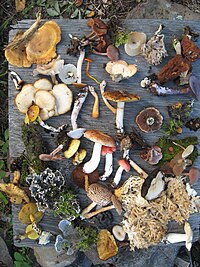
Photo from wikipedia
Different processes drive spatial variation in community composition. Standard measures of composition are useful in species‐based conservation and ecology, but they may be less informative in the context of evolutionary… Click to show full abstract
Different processes drive spatial variation in community composition. Standard measures of composition are useful in species‐based conservation and ecology, but they may be less informative in the context of evolutionary history and functional diversity. Functional and phylogenetic approaches are increasingly used to test mechanisms driving biodiversity patterns. We studied 28 families of flies (Diptera) with a range of functional characteristics in three wetland classes (bogs, swamps, marshes) in Quebec, Canada. We examined taxonomic, phylogenetic and functional structure of communities and assessed whether rarity is deterministic or stochastic. Beta‐ and phylobeta‐diversity were also examined for relatedness to local environmental conditions, patch area, and/or surrounding landscape. Phylogenetic community structure analyses had high value and complementarity to standard measures. Environmental filtering acted on bog communities during assembly, as they emerged from a slow peat accumulation process and the plant composition is characteristic as few species can survive in these acidic and low nutrient conditions. Subsequently, community assembly happened randomly. Neutral processes of community assembly are more important in marshes and swamps, as dispersal limitation explained species abundance dynamics of small and common Diptera species. The assembly of marsh communities is a balance between neutral processes and environmental filtering, while assembly in swamps can be seen as neutral. Clustering increased with environmental extremes, indicating environmental filtering. Rare species tended to be less closely related to common species. They have unique habitat requirements, and the high diversity is maintained by temporal turnover of species with similar traits filtered by the environment.
Journal Title: Insect Conservation and Diversity
Year Published: 2018
Link to full text (if available)
Share on Social Media: Sign Up to like & get
recommendations!